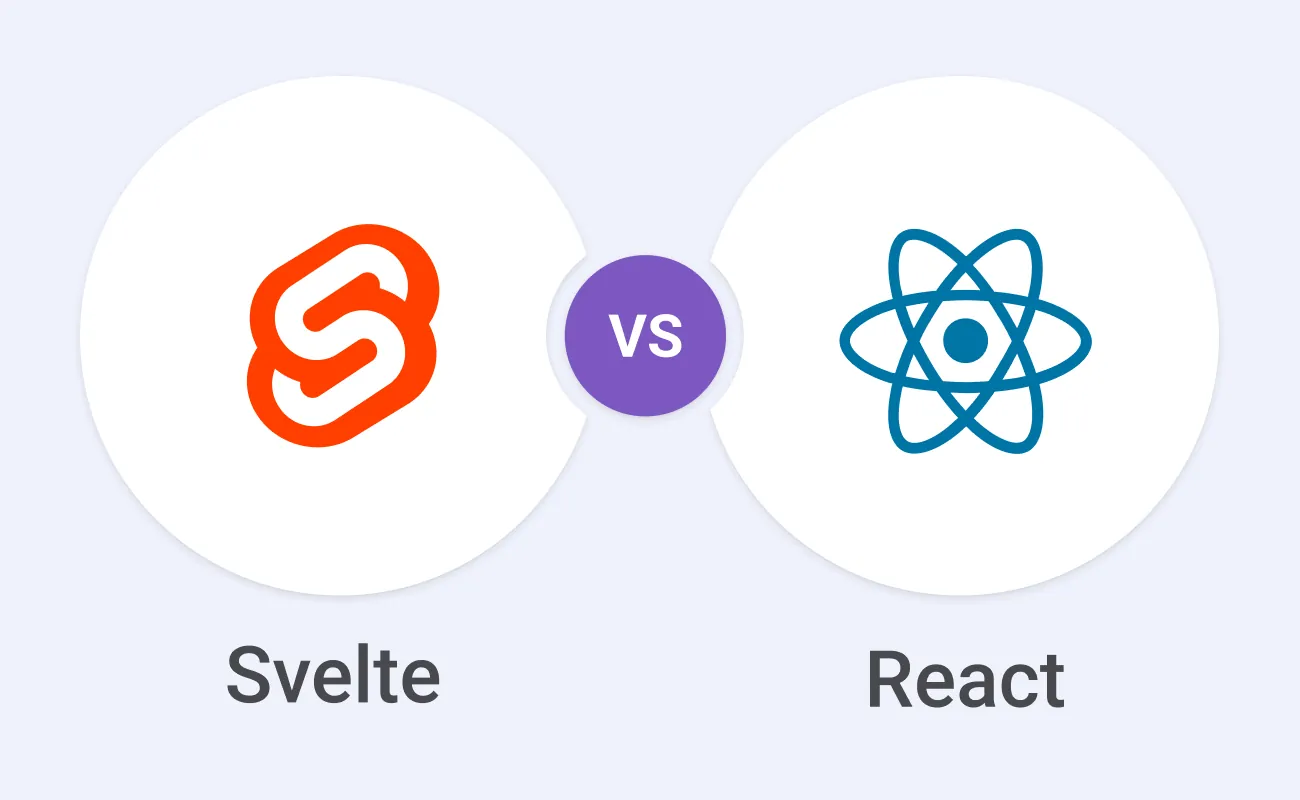Are you considering using Svelte or React for your next project? Both are used for building interactive user interfaces, but have different approaches to the task. React is a JavaScript library, while Svelte is a framework that takes a compiler-based approach. Today we would like to talk about these two popular tools and when to use each.
This article highlights 10 key factors to consider when selecting the best framework for your project. Step by step, we’ll compare Svelte and React to clarify their differences and help you determine which one best fits your needs. Let’s dive in!
Why Svelte and React?
We chose React and Svelte as we wanted to compare the widely-adopted gold standard of frontend development, with an alternative that proved well in building web interfaces and got positive feedback from software engineers.
These frameworks vary in syntax, state management, and performance optimization strategies, making the comparison intriguing. Plus, since SVAR offers UI components for both Svelte and React, we wanted to guide you through the decision-making process.
Let’s move on to the brief overview of the frameworks before getting into the details.

Svelte and React: Brief Overview
Svelte is an open-source frontend framework that uses a compiler for processing components into highly optimized JS code - as a result users benefit from higher client-side performance. The key features include:
- compiled code;
- optimized bundle size;
- components reactivity;
- ability to use components as standalone packages.
React is an open-source JS library for creating dynamic user interfaces with the component-based approach in its core. Its most notable features include:
- virtual DOM;
- JavaScript Syntax Extension (JSX);
- one-direction data flow;
- functional components and React hooks.
Well, do you notice some key differences in some concepts already? That’s the whole point! The more differences we analyze, the better our chances of choosing the best option.
Svelte vs React: Key Factors to Consider
Below you’ll find a list of key factors to consider before choosing between Svelte and React. You can use it as a checklist for evaluating these two frameworks.
1. Performance
To begin with, we should admit that both Svelte and React can be characterised as frameworks that deliver high performance. They just approach this issue in different ways.
React: Run-time Approach and the Virtual DOM
React is a library with the run-time approach that uses the concept of the virtual DOM. This means it avoids direct interaction with the real DOM and frequent re-rendering as it drops performance down.
Well, how does the virtual DOM model work? When the UI is rendered for the first time, React creates a virtual copy of the real DOM and keeps it in memory. When further changes occur, the UI is re-rendered in the virtual DOM. Then React compares these two virtual structures, finds the differences and applies changes only to the parts of the UI in the real DOM that need to be updated. And this is what makes React highly performant.
Svelte: Compile-time Approach and No Virtual DOM
Svelte doesn’t use the virtual DOM. Instead, it compiles components into optimized JavaScript that directly manipulates the real DOM. In fact, Svelte doesn’t need the virtual DOM because it compiles components at build time, eliminating the need for runtime diffing. This means that unlike most of the popular frontend frameworks it does the heavy lifting during the build time, but not in the browser. As a result, it has a smaller bundle size and high performance rates.
2. Development Speed
Both Svelte and React have a component-based approach to building apps aimed at accelerating the development process. This means that you can create separate building blocks and then reuse them in different parts of the application. This helps avoid repetitive code and enables engineers to build projects much faster.
When it comes to syntax, dependencies and configuration, Svelte is much more minimalistic than React and is a very good option for small-scale apps. Its simplicity can significantly speed up the designing of a project. By the way, React is often the better choice for large applications, as it scales more effectively than Svelte.
3. The Learning Curve
As for the learning curve, it is obviously steeper in React. Developers often say that you need to “think in React” to successfully use it on your project. This means that you really need to understand how it works, get used to its syntax (JSX) and the data flow model. You also have to get familiar with a number of additional tools for state management or routing, as React does not natively support this functionality.
Svelte syntax is quite simple and you can easily get the hang of it, especially if you are familiar with HTML, CSS and JavaScript. Svelte components encapsulate HTML, CSS and JS, having the markup, style and logic in one place. You will for sure need time to study it, but the learning curve is really gentle.
4. Project Scale & Complexity
If you’re planning to design a minimalistic small-scale or a medium-scale app, Svelte will be a better option. Its minimalistic nature and compile-time optimizations allow for faster development and smaller bundle sizes, which makes it ideal for simpler projects. However, even for larger apps, Svelte can still be used effectively as long as the architecture doesn’t become too complex.
In case your app is a large and complex system with interactive UI and real-time updates - React will be a better choice. Its well-developed ecosystem provides all necessary tools and libraries for any possible case, which means you unlikely will find yourself in a situation when you are stuck at some point and can not find a well-suited solution.
Another thing to mention is SSR (Server-Side Rendering), which is an important factor to consider if your project requires strong SEO capabilities. React integrates seamlessly with Next.js, a mature framework that provides efficient SSR support, making it an excellent choice for SEO-heavy applications. Svelte also supports SSR through SvelteKit, but the ecosystem around it is still growing. While both frameworks offer SSR solutions, React has a more established approach, which can be beneficial for large-scale web apps that rely on search engine visibility.
5. State Management
Here we have again some differences in how state is managed in Svelte and React. Svelte has a built-in system of state management which is rather straightforward and easy to understand. You can manage state using the mechanisms (e.g. runes in Svelte 5) that are a part of the framework itself, so you don’t need any additional libraries for this purpose.
React’s state management is more flexible but requires different tools based on the complexity of the app. For small-scale projects, the useState and useContext hooks can work well. However, for larger projects with more complex state, it’s common to rely on third-party libraries like Redux, MobX, or Zustand to manage global state more efficiently.
While React itself doesn’t provide a full-fledged state management solution out of the box (other than the Context API), the flexibility of choosing your preferred solution can be a strength for more complex applications.
6. TypeScript Support
TypeScript is becoming more and more widely used in software development. Its popularity increases each year and it is not surprising - this technology allows using data types and helps avoid errors associated with their incorrect utilization, contributing to the scalability and maintainability of the app. That is why it is so important to choose tools with the TypeScript support.
Both Svelte and React support the use of TypeScript within their components. Its implementation in Svelte is straightforward, you just add lang=”ts” to the <script> tag and you are done.
React requires more setup. You can install TypeScript via npm or yarn, then create .tsx files for components that use JSX syntax. TypeScript integration in React isn’t as seamless as in Svelte, but it’s still a powerful tool that works well with the React ecosystem and can be fully customized.
7. Tooling and Ecosystem
In terms of the available tools, React is way ahead of Svelte. React developers have access to a wide variety of libraries, a well-developed community, a really huge code base, comprehensive documentation, and active forums with answers to nearly every possible question. If you encounter an issue, there’s almost always a solution available. What is more, you will have a number of well-designed solutions to choose from.
Svelte doesn’t yet offer an ecosystem as expansive as React’s. It has fewer libraries and a smaller community of developers. However, the framework is evolving rapidly and gaining more popularity due to its performance advantages and minimalistic approach to building apps. As a result, new Svelte libraries and tools continue to emerge.
8. UI Component Libraries
Both Svelte and React are frameworks for creating user interfaces. This means that you can design your custom components of any complexity using the possibilities they provide. However, the process of building UIs from scratch can be really time-consuming.
Luckily, today we have access to a wide variety of third-party UI libraries that can be easily integrated into your project. This allows investing more time and resources into the development of your app’s logic and less on designing individual components from the ground up.
There are a lot of open-source UI libraries for React, like Chakra UI, MUI, Ant Design, or Mantine, so you can choose the one that suits you most. As for Svelte, there are Flowbite Svelte, SvelteUI, Svelte Material UI, or SVAR Svelte Core Library. SVAR UI components stand out with their thoughtful and attractive design, fast performance, responsive design and customization capabilties.
9. Team Experience
JavaScript developer community survey show that React is the undisputed leader in terms of the number of software engineers who use it in their everyday work. The share of React developers exceeds 80%, while that of Svelte is about 25%. The good news is that Svelte already holds the fourth position on the list of the most commonly used JS frameworks.
What does all that mean? Well, if you decide on React for your project, you should not have any difficulties to gather your development team. And here React has an advantage over Svelte.
However, for web developers Svelte learning curve is gentle, so starting using and mastering it will not take much time in most cases. Moreover, the mentioned survey shows that Svelte keeps ranking high for positive feedback, which means your team will be a little bit happier than the one that uses React :)
10. Enterprise Adoption
We have already mentioned that React is a more mature solution for web development which is widely adopted by businesses. Does that mean Svelte is a newcomer unsuitable for enterprise applications? Absolutely not!
Let’s look through the list of companies that have their apps built in React. Here we have Facebook, Instagram, Netflix, BBC, Airbnb, Tesla, Shopify, Pinterest - and this is by no means a comprehensive list. Looks really impressive.
But what about Svelte? Apple, New York Times, Cloudflare, IKEA, Spotify - the list is no less impressive.
The conclusion we can draw here is that large enterprises trust both React and Svelte when it comes to creating their business products. So, why shouldn’t we?
What Fellow Developers Say
Many developers love Svelte for its simplicity and performance, often describing it as “a breath of fresh air” compared to traditional frameworks. Again, surveys, such as State of JS, consistently rank Svelte at the top for developer satisfaction.
However, React remains the go-to choice for enterprise projects due to its vast ecosystem and widespread adoption. Developers frequently mention React’s strong community support and vast job opportunities as reasons to stick with it. While some criticize React’s complexity and reliance on third-party tools, its robustness makes it a staple in modern web development.
Conclusion
In this article we considered the key points that can determine our choice in favor of React or Svelte: performance and development speed, the learning curve and team expertise, the ecosystem and tooling, enterprise adoption and project scale. So, the general recommendations are:
Use React if:
- You need a mature ecosystem with extensive third-party libraries.
- You’re building a large-scale or complex project requiring advanced state management.
- You want strong TypeScript support and robust SSR capabilities (Next.js).
- Your team already has React experience (more developers available).
Use Svelte if:
- You prioritize performance (faster runtime, smaller bundle sizes).
- You want a simpler, easier-to-learn framework with a more intuitive syntax.
- You’re working on a small to medium-scale project without complex state management needs.
- You want to experiment with a modern, compiler-based approach.
- You value developer experience and happiness (Svelte often ranks highly in satisfaction surveys).
In summary, both Svelte and React are reliable, production-ready choices used by large enterprises. Before choosing one, it’s important to carefully consider the factors that matter for your specific project. We hope this list will help you make the right decision on your way to build innovative business solutions.


